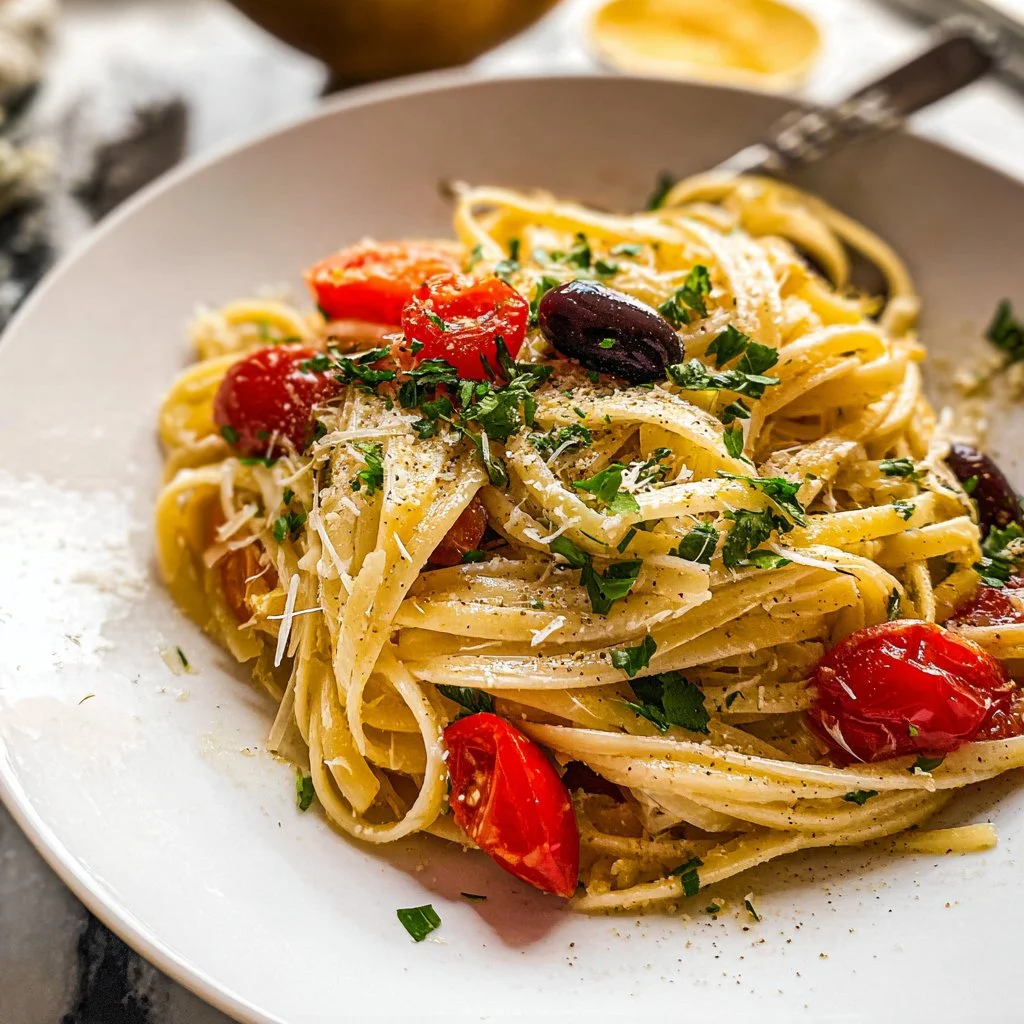Greek pasta is a fresh, flavorful dish that brings the taste of the Mediterranean to your table. With classic Greek ingredients and tender pasta, it’s a quick and comforting meal that’s both vibrant and satisfying.
Why We Love This Greek Pasta Recipe
This Greek pasta is a crowd-pleaser for numerous reasons. First, it encapsulates the essence of Greek cuisine: fresh ingredients, rich flavors, and a hint of simplicity. You don’t need to spend hours in the kitchen to impress your family or guests; this recipe is straightforward and quick, making it perfect for any occasion.
Moreover, this dish is incredibly versatile. You can tweak it based on what you have on hand or your personal taste preferences. Whether you want to load it up with more vegetables or add your favorite herbs, the possibilities are endless. The combination of creamy feta, earthy herbs, and a medley of vegetables creates a dish that feels both comforting and gourmet.
Let’s get started! Here’s everything you need to know to whip up this delightful Greek pasta recipe that will surely become a staple in your kitchen.
Ingredients for Greek Pasta
To make this delicious Greek pasta, you will need the following ingredients:
- 16 oz. pasta, cooked until al dente (save 1/2 a cup of pasta water!)
- 1 tablespoon olive oil
- 6 cloves garlic, thinly sliced
- 1 teaspoon dried oregano
- 1 teaspoon dried thyme
- 8 oz. feta cheese
- 1/2 cup heavy cream
- 1/2 cup pasta water
- 1 pint grape tomatoes, halved
- 1 (15 oz.) can quartered artichoke hearts, drained
- 1 (4.8 oz.) jar ripe olives
- Fresh chopped parsley for garnish
- Grated Parmesan for garnish
- Crumbled feta for garnish
How to Make Greek Pasta
Creating this delectable Greek pasta is a breeze! Here’s a step-by-step guide to ensure you get it just right.
First, start with a large pot over medium heat. Drizzle in the olive oil and let it warm up. Once the oil is hot, add the thinly sliced garlic, dried oregano, dried thyme, and a pinch of salt and pepper. Make sure to stir the ingredients frequently to avoid any burning, cooking for about a minute until the garlic is fragrant.
Next, it’s time to incorporate the feta cheese and heavy cream into the pot. Reduce the heat to medium-low, and stir the mixture gently for around 2-3 minutes. You’ll want the feta to melt down and form a creamy, flavorful sauce that will coat your pasta beautifully.
Once the sauce is ready, add the cooked pasta and half a cup of the reserved pasta water to the pot. Toss everything together so the pasta gets evenly coated in that delicious sauce. If it seems a little dry, don’t hesitate to add a touch more pasta water until you reach your desired consistency.
Now, you can bring in the stars of this dish: the halved grape tomatoes, drained artichoke hearts, and ripe olives. Season to taste with a little extra salt and pepper if necessary. Stir everything together until it’s warm, which will only take about a minute.
To finish it off, serve your Greek pasta in bowls. Dress it up with a sprinkle of freshly chopped parsley, a generous handful of grated Parmesan cheese, and some crumbled feta for that extra touch of flavor.
How to Serve Greek Pasta
Serving Greek pasta can be just as important as making it. Presentation can elevate the dining experience, making your meal feel more special. Start by serving the pasta in attractive bowls or plates to create a visually pleasing display.
Garnishing is key! As mentioned, sprinkle freshly chopped parsley on top for a vibrant pop of color and freshness. You can also offer extra grated Parmesan cheese and crumbled feta on the side for those who might want a richer flavor profile.
Pair your Greek pasta with a light side salad or some warm, crusty bread to soak up the delicious creamy sauce. If you desire a refreshing drink, consider serving it with sparkling water or a non-alcoholic beverage that complements the flavors of the dish. Enjoy every bite!
Expert Tips for the Perfect Greek Pasta
To elevate your Greek pasta to perfection, consider these expert tips that can enhance both the preparation and flavor:
- Choose Quality Ingredients: The quality of your olive oil and feta cheese can significantly impact the dish’s overall flavor. Opt for extra virgin olive oil and a good block of feta cheese for the best results.
- Don’t Overcook the Pasta: Ensuring that your pasta is cooked al dente is crucial. Overcooked pasta can become mushy and lose its ability to hold onto the sauce.
- Experiment with Vegetables: Feel free to get creative with vegetables! Spinach, bell peppers, or zucchini could make great additions. Simply sauté them along with the garlic for a nutritious boost.
- Adjust Seasonings: If you’re a fan of spice, a pinch of red pepper flakes can add a delightful kick to the dish.
- Make It Ahead: This Greek pasta can be made ahead of time, making it a perfect dish for meal prep. Simply reheat gently when you’re ready to eat!
How to Store Greek Pasta
If you happen to have leftovers (which might be a rarity because this dish is downright delicious), storing Greek pasta correctly is essential. Allow it to cool down to room temperature before transferring it to an airtight container. It’s best to store the pasta in the refrigerator, where it can stay fresh for about 3-4 days.
When reheating, add a splash of pasta water or a little olive oil to revive the creaminess of the sauce. Gently reheat on the stovetop over low heat or in the microwave until warmed through, adding more liquid as necessary to get the perfect consistency back.
Variation of Greek Pasta
This Greek pasta can be easily customized to suit your tastes or dietary needs. Here are a few delightful variations:
- Vegetarian Delight: Keep it meat-free by adding more vegetables like bell peppers, spinach, or artichokes. You can also toss in some chickpeas for added protein.
- Protein-Packed: Want to amp up the protein? Consider adding grilled chicken or shrimp to the pasta. They pair wonderfully with the Greek flavors and turn this dish into a wholesome meal.
- Gluten-Free Option: You can swap out the regular pasta for gluten-free pasta. The rest of the ingredients remain the same, ensuring you still get that delightful Greek taste.
- Herb Infusion: Try using fresh herbs instead of dried. Fresh oregano or thyme can brighten the flavors even more, giving you that garden-fresh essence in every bite.
FAQ about Greek Pasta
What type of pasta is best for Greek pasta?
You can use various pasta types, but shapes like penne, fusilli, or farfalle work especially well as they hold the creamy sauce beautifully.
Can I make Greek pasta vegan?
Yes! Replace the feta cheese with a plant-based alternative, and substitute heavy cream with coconut milk or a nut cream. You’ll still get a rich taste and maintain the essence of this Greek dish.
How can I make Greek pasta spicy?
If you love a bit of heat, add red pepper flakes when cooking the garlic or toss in some diced jalapeños when adding the vegetables.
Can I prepare this dish in advance?
Absolutely! Greek pasta keeps well in the fridge, and the flavors meld nicely over time. Just reheat gently and add a splash of water or olive oil to make it creamy again.
Is it possible to freeze Greek pasta?
While you can freeze it, keep in mind that the texture of the sauce may change slightly after thawing. It’s best to store it fresh, but you can definitely freeze leftovers if needed.

Greek Pasta
Ingredients
Pasta and Sauce
- 16 oz pasta, cooked until al dente Save 1/2 cup of pasta water!
- 1 tablespoon olive oil Use extra virgin for best flavor.
- 6 cloves garlic, thinly sliced Add more for stronger flavor.
- 1 teaspoon dried oregano Fresh oregano can be used for added flavor.
- 1 teaspoon dried thyme Substitute with fresh thyme if preferred.
- 8 oz feta cheese Crumbled for easy incorporation.
- 1/2 cup heavy cream Can substitute with coconut milk for a vegan option.
- 1/2 cup pasta water Reserved from cooking pasta.
Vegetables
- 1 pint grape tomatoes, halved Substitute with cherry tomatoes if needed.
- 1 can quartered artichoke hearts, drained Use canned or frozen artichokes.
- 1 jar ripe olives Chopped olives can be used for better distribution.
Garnishes
- to taste Fresh chopped parsley For garnish.
- to taste Grated Parmesan For serving alongside.
- to taste Crumbled feta Optional additional garnish.
Instructions
Cooking
- In a large pot over medium heat, drizzle olive oil and warm it up.
- Add garlic, dried oregano, dried thyme, salt, and pepper. Stir frequently and cook for about a minute until fragrant.
- Add feta cheese and heavy cream, reducing the heat to medium-low, stirring gently for 2-3 minutes until creamy.
- Incorporate cooked pasta and half a cup of reserved pasta water, tossing to coat evenly.
- Add halved grape tomatoes, drained artichoke hearts, and ripe olives, stirring until warmed through (about 1 minute).
- Serve in bowls and garnish with chopped parsley, grated Parmesan, and crumbled feta.
Send me this recipe!
Just enter your email below and get it sent straight to your inbox!



